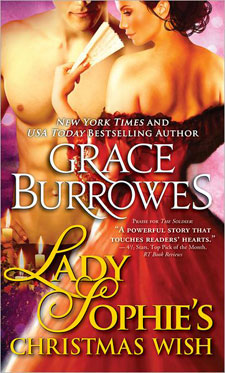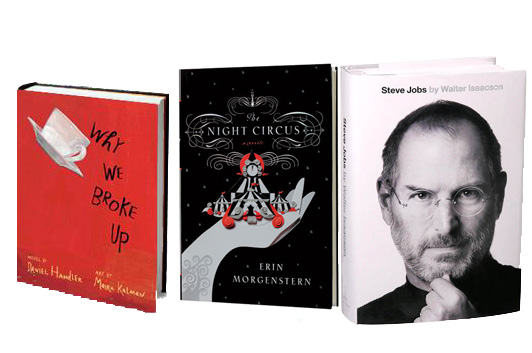Read This: Lady Sophie’s Christmas Wish
 Longtime Beatrice readers might recall that I read a batch of Christmas-themed romances around this time last year; I meant to repeat the project this holiday season, but was only able to get to Lady Sophie’s Christmas Wish by Grace Burrowes before the 25th.
Longtime Beatrice readers might recall that I read a batch of Christmas-themed romances around this time last year; I meant to repeat the project this holiday season, but was only able to get to Lady Sophie’s Christmas Wish by Grace Burrowes before the 25th.
Although Lady Sophie’s Christmas Wish is the first in a sequence of novels spun off from Burrowes’ bestselling “Duke’s Obsession” trilogy (The Heir, The Soldier, and The Virtuoso), that doesn’t really come into play until you’re already well into the story. It begins at a London inn, where Vim (short for Wilhelm) Charpentier is trying to find a seat on a carriage to Kent in the middle of a snowstorm. He’s distracted by a squalling child, which is how he meets Sophie Windham, who was there to see the baby boy and his mother off on another carriage—except that the mother, a servant in Lady Sophie’s household, elects to pull a runner, leaving the child behind. Now it’s crucial here that Sophie doesn’t tell Vim that she’s a Lady, and the daughter of the Duke of Moreland, allowing him to think that she’s another servant in the mostly-empty household. (The Duke and Duchess have gone off to their country estate, where they are expecting Sophie, along with her brothers, who are the heroes of Burrowes’ previous romances.) This frees the couple up to spend several days (almost entirely) alone together with young Kit in a snowed-in house while Vim shows Sophie how to raise a baby—he’s had a lot of step-siblings—and they fall in love.
The story’s execution isn’t quite perfect: The scenes where Burrowes breaks away from Vim and Sophie to check in on the brothers who are on their way to collect her for the family reunion, or to note the anxiety of the Duke and Duchess and Vim’s aunt and uncle, are well-done, but they’re also distracting—though readers who are already Burrowes fans might welcome the opportunities to see how her heroes have been faring. On the other hand, you do need some sense of the brothers’ personalities for the back half of the book, as they react to discovering Vim and Sophie’s developing relationship, so it’s not as if you can cut those passages. The more significant problem, from my perspective, was that Vim’s backstory hinges on a slight suffered at the hands of Moreland so humiliating that it’s driven him to spend the last dozen years sailing the globe in order to be anywhere other than home—clearly a life-defining incident, and yet he fails to recognize that Windham is the Moreland family name. That part of the story just doesn’t seem plausible.
What does seem plausible, even under the contrived circumstances, is the slow burn of the attraction between Vim and Sophie. It gets a bit talky at times, in that “let’s lay the emotional subtext out on the table and dissect it” way, but there’s a core authenticity to the way the two interact, and then in the way that the hurt and confused Vim interacts with Sophie’s aggressive brothers. The dialogue swerves into anachronism occasionally (I’m pretty sure “shut up and listen” isn’t Regency-era speech), but no more so, at least to my ears, than is generally acceptable within the genre, and the motivations beneath the dialogue feel convincingly genuine. Vim in particular is a likeable hero, worldly but gentle if a bit pigheaded about clinging to the past, and his strengths as a character compensate for the weaknesses of Sophie as the sensible but lonely duke’s daughter who yearns to push the envelope of propriety to discover intimacy.
So, what about the Christmas aspect? In that regard, Lady Sophie fares slightly better than last year’s reading, in that the action is all confined to late December, and the immanence of Christmas is evident throughout. That said, it’s not so much a Christmas story that one wouldn’t be able to read it at any other time of the year, which is only proper considering that it fits into a larger sequence of Burrowes’ stories. And it definitely has me interested enough to pick up the copy of The Soldier that’s kicking around in my bookcase at some point…
28 December 2011 | read this |
These Are a Few of My Favorite Books

This year, I’m fortunate enough to have two steady book reviewing gigs—I’m about halfway through my second year of working with Shelf Awareness, where I started out reviewing science fiction and fantasy but have steadily branched out into other genres and even the occasional “literary” novel, and then this summer I began working on the “Writing” section of USA’s Character Approved blog, which “celebrates the people, places and things that are… changing the face of American culture.” This means that I got to write two “top ten” lists at the end of the year; my Character Approved list concentrated on American authors (and a few publishers, and one designer), but my Shelf Awareness picks could include writers from each of the three nations of Great Britain, plus Haruki Murakami.
(1Q84 is a novel I actually got to write about at one of my semi-regular venues, Tor.com, where I contributed a long essay about the unmistakable influence of Philip K. Dick. Unmistakable, that is, unless you were reviewing the novel for the New York Times, in which case you thought Murakami’s fantastical vibe was more like Kurt Vonnegut or just plain incomprehensible.)
But these two lists don’t have all my favorite books from 2011, because I don’t review books written by my friends for either publication (although I’ve had conversations with editors about whether some online acquaintances are “friends” or not, and I’ve been lucky enough to get to know some writers better after I’ve written about them). But I can talk about those books here, so I can tell you to pre-order the trade paperback of Deb Olin Unferth’s memoir, Revolution, that’s coming out in early 2012. You could also get Anna David’s Falling for Me, which was a trade paperback original. Two friends published novels about love and family and food recently: Diana Abu-Jaber’s Birds of Paradise and N.M. Kelby’s White Truffles in Winter
If you’re a romance fan, you’ll want to track down Sarah MacLean’s Eleven Scandals to Start to Win a Girl’s Heart and Eloisa James’s The Duke is Mine. One of my former co-workers at Amazon, Stefanie Sloane, made her debut as a romance writer this year; start with The Devil in Disguise and if that catches your fancy, she’s already got several books out! (This is a category where I’m blanking on a specific titles as I try to write this post, but of course I can’t forget my Lady Jane’s Salon colleagues—Hope Tarr, Maya Rodale, and Leanna Renee Hieber—all of whom have had new work or reissues of previous books released this year. The Lady Jane’s guest lists will also steer you towards some fantastic reads.)
My favorite book of 2011, though, just might be John Scalzi’s Fuzzy Nation, a “reboot” of H. Beam Piper’s Little Fuzzy that plays to all of Scalzi’s best strengths as a storyteller. It’s a screwball comedy about contract law and trial procedure, it’s a tearjerker about the discovery of sentient life on a corporate mining planet, it’s a heartwarming story about a smart guy who learns how to stop being a jerk. The only thing that’s keeping me from saying outright that it’s my favorite book of the year is that Erin Morgenstern’s The Night Circus is a stunningly gorgeous fantasy novel. The only book that came as close to producing the all-immersive captivation The Night Circus inspired was Neal Stephenson’s Reamde, but as wonderful as that book is—including one of the most amazing sequences I’ve ever read in any novel—The Night Circus just feels more… seamless, if that’s the word I’m looking for.
I know I must be leaving out a bunch of books, for which I apologize both to the authors I’m overlooking and to the readers who would enjoy those books as much as I did—but have a look around the archives, and stick around for 2012’s posts, and I’m confident most of you won’t be disappointed by what you find.
23 December 2011 | read this |

 Our Endless and Proper Work is my new book with Belt Publishing about starting (and sticking to) a productive writing practice.
Our Endless and Proper Work is my new book with Belt Publishing about starting (and sticking to) a productive writing practice. 
